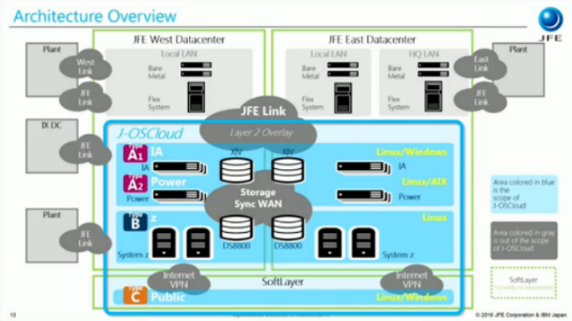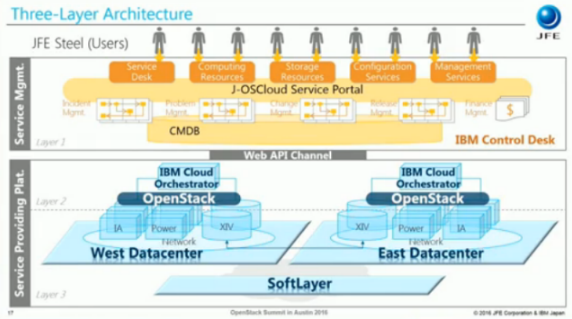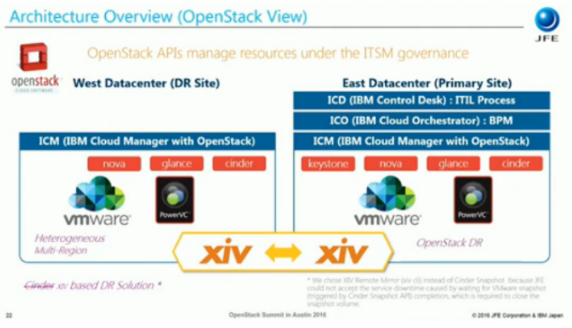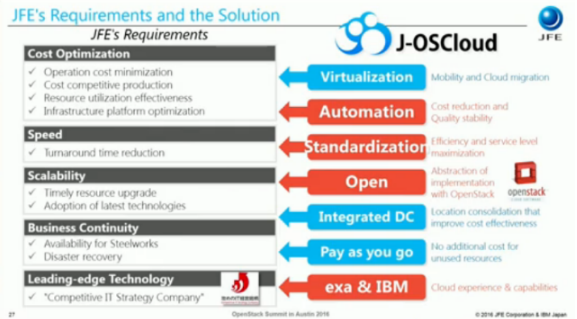One of the largest corporations in Japan, JFE Steel produces 30 million tons of crude steel per year, making it the second producer in Japan and ninth in production worldwide.
Steel producers like JFE have a critical need for cost optimization, speed, scalability and business continuity. The latter is particularly essential; if the steelworks stops, it can take months and costs hundreds of millions of dollars to return to normal operations. This means that operating efficiency and distribution of risk are among JFE’s top concerns. However, JFE’s data center operations had been lacking integrated system management, leaving the company exposed to inefficiencies and sub-optimal risk management.
Representatives from JFE and IBM Japan recently presented at the OpenStack Summit in Austin, speaking about the design and implementation of J-OSCloud, an OpenStack-based private cloud service just launched this April, which was introduced to meet JFE’s needs.
Kentaro Watanabe, staff manager of the IT Innovation Leading Department at JFE and owner of the J-OSCloud project, detailed the key pieces of JFE’s move to a more advanced infrastructure: implementing cloud solutions and a virtual data center while embracing open source and standardization. Watanabe explained his belief that “IT resources should be shared, but risks should be distributed,” and projected that implementing J-OSCloud would reduce IT costs by 28 percent while offering more flexibility, mobility, and availability of business applications.
Takuma Kawai of IBM Japan, the chief architect for JFE Steel Corporation and lead on the J-OSCloud project, then took the microphone to highlight the service’s design. This included creating an “integrated data center” by consolidating down to two locations and making the most of network virtualization, Doing so “drove the consolidation of physical servers, improved CPU utilization 30-70 percent over previous usage and contributed to cost optimization.”

Kawai explained how J-OSCloud is built to meet assumed changes to the business environment and to satisfy JFE’s scalability requirements for the next half decade by preparing to utilize up to 500 virtual machines. Importantly, J-OSCloud achieves valuable automation using IBM Cloud Orchestrator, a tool that bundles a business process manager (BPM) and an IBM version of OpenStack called “IBM Cloud Manager with OpenStack” (ICM).

Kawai said, “For the physical infrastructure, we have to provide a variety of platforms to fulfill customers’ needs, including both VMWare and PowerVM. This is why we took advantage of OpenStack. Without OpenStack, we would have had to develop different automation scripts on each platform. We would not have been able to complete our project within our time and budget limits. Also, before J-OSCloud it could take two weeks to the release of a virtual machine – this is now been cut down to three working days. Three working days is now a key performance indicator between JFE and IBM.”

J-OSCloud utilizes a selection of Openstack components – including Keystone, Nova, Glance and Cinder – to achieve everything from data storage to data recovery. By depending on OpenStack’s open standards, Kawai’s team was able to build an automated provisioning system without proprietary APIs from VMware or PowerVM. Kawai described the choices made: “Our first architectural decision was the scope of OpenStack, and which components should be applied. We set a ground rule to only use OpenStack APIs to manage virtual instances. We knew we had to stick to standardizations supported by OpenStack when we designed our architecture framework. We tried to keep our OpenStack configuration as simple as possible, to sustain management efficiency. Even so, given our architecture we’ve installed six OpenStack packages in total. That’s a lot of OpenStack!”

Kawai concluded that what’s made J-OSCloud great is that it really combines everything JFE requires, from IT processes to infrastructure to services. “Hardware procurement, kitting, racking, design and installation, systems management – in the past we were doing each of those tasks at an individual project level,” Kawai explained. With J-OSCloud, they were able to prepare the resources and tools ahead of time to be shared across projects. This enables them to reduce lead-time and cost overhead. As Kawai succinctly put it: “J-OSCloud powerfully aligns IT services with JFE’s business needs.”
Cover Photo of JFE’s East Japan Steelworks by Saeko Jimyoin // CC BY NC
- How State Grid Corporation of China cuts IT costs, eludes vendor lock-in with OpenStack - July 13, 2016
- Lenovo enlists OpenStack to support enterprise clients with business innovation - July 12, 2016
- How JFE Steel Corporation forged an integrated data center with help from IBM Japan and OpenStack - July 6, 2016

)







